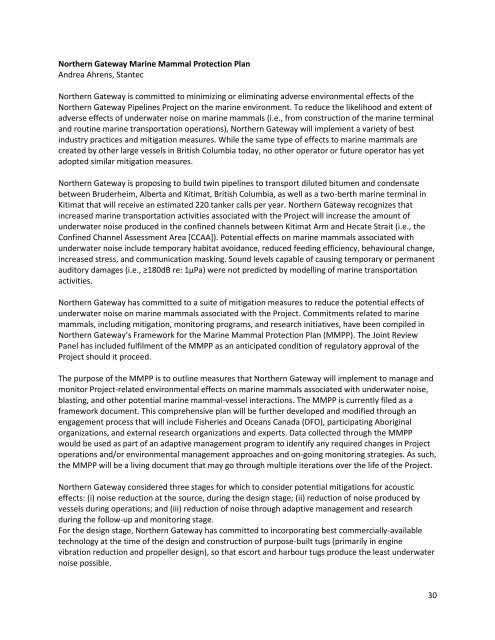mcbem-2014-01-submission-wwf-en
mcbem-2014-01-submission-wwf-en
mcbem-2014-01-submission-wwf-en
You also want an ePaper? Increase the reach of your titles
YUMPU automatically turns print PDFs into web optimized ePapers that Google loves.
Northern Gateway Marine Mammal Protection Plan<br />
Andrea Ahr<strong>en</strong>s, Stantec<br />
Northern Gateway is committed to minimizing or eliminating adverse <strong>en</strong>vironm<strong>en</strong>tal effects of the<br />
Northern Gateway Pipelines Project on the marine <strong>en</strong>vironm<strong>en</strong>t. To reduce the likelihood and ext<strong>en</strong>t of<br />
adverse effects of underwater noise on marine mammals (i.e., from construction of the marine terminal<br />
and routine marine transportation operations), Northern Gateway will implem<strong>en</strong>t a variety of best<br />
industry practices and mitigation measures. While the same type of effects to marine mammals are<br />
created by other large vessels in British Columbia today, no other operator or future operator has yet<br />
adopted similar mitigation measures.<br />
Northern Gateway is proposing to build twin pipelines to transport diluted bitum<strong>en</strong> and cond<strong>en</strong>sate<br />
betwe<strong>en</strong> Bruderheim, Alberta and Kitimat, British Columbia, as well as a two-berth marine terminal in<br />
Kitimat that will receive an estimated 220 tanker calls per year. Northern Gateway recognizes that<br />
increased marine transportation activities associated with the Project will increase the amount of<br />
underwater noise produced in the confined channels betwe<strong>en</strong> Kitimat Arm and Hecate Strait (i.e., the<br />
Confined Channel Assessm<strong>en</strong>t Area [CCAA]). Pot<strong>en</strong>tial effects on marine mammals associated with<br />
underwater noise include temporary habitat avoidance, reduced feeding effici<strong>en</strong>cy, behavioural change,<br />
increased stress, and communication masking. Sound levels capable of causing temporary or perman<strong>en</strong>t<br />
auditory damages (i.e., ≥180dB re: 1µPa) were not predicted by modelling of marine transportation<br />
activities.<br />
Northern Gateway has committed to a suite of mitigation measures to reduce the pot<strong>en</strong>tial effects of<br />
underwater noise on marine mammals associated with the Project. Commitm<strong>en</strong>ts related to marine<br />
mammals, including mitigation, monitoring programs, and research initiatives, have be<strong>en</strong> compiled in<br />
Northern Gateway’s Framework for the Marine Mammal Protection Plan (MMPP). The Joint Review<br />
Panel has included fulfilm<strong>en</strong>t of the MMPP as an anticipated condition of regulatory approval of the<br />
Project should it proceed.<br />
The purpose of the MMPP is to outline measures that Northern Gateway will implem<strong>en</strong>t to manage and<br />
monitor Project-related <strong>en</strong>vironm<strong>en</strong>tal effects on marine mammals associated with underwater noise,<br />
blasting, and other pot<strong>en</strong>tial marine mammal-vessel interactions. The MMPP is curr<strong>en</strong>tly filed as a<br />
framework docum<strong>en</strong>t. This compreh<strong>en</strong>sive plan will be further developed and modified through an<br />
<strong>en</strong>gagem<strong>en</strong>t process that will include Fisheries and Oceans Canada (DFO), participating Aboriginal<br />
organizations, and external research organizations and experts. Data collected through the MMPP<br />
would be used as part of an adaptive managem<strong>en</strong>t program to id<strong>en</strong>tify any required changes in Project<br />
operations and/or <strong>en</strong>vironm<strong>en</strong>tal managem<strong>en</strong>t approaches and on-going monitoring strategies. As such,<br />
the MMPP will be a living docum<strong>en</strong>t that may go through multiple iterations over the life of the Project.<br />
Northern Gateway considered three stages for which to consider pot<strong>en</strong>tial mitigations for acoustic<br />
effects: (i) noise reduction at the source, during the design stage; (ii) reduction of noise produced by<br />
vessels during operations; and (iii) reduction of noise through adaptive managem<strong>en</strong>t and research<br />
during the follow-up and monitoring stage.<br />
For the design stage, Northern Gateway has committed to incorporating best commercially-available<br />
technology at the time of the design and construction of purpose-built tugs (primarily in <strong>en</strong>gine<br />
vibration reduction and propeller design), so that escort and harbour tugs produce the least underwater<br />
noise possible.<br />
30


